.
Hunde im antiken und modernen Griechenland
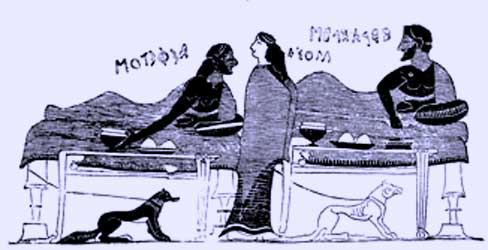
...among which it is reported that Xanthippus, the father of Pericles, had a dog that would not endure to stay behind, but leaped into the sea, and swam along by the galley’s side till he came to the island of Salamis, where he fainted away and died, and that spot in the island, which is still called the Dog’s Grave, is said to be his. Plutarch Themistocles
As they were thus talking, a dog that had been lying asleep raised his head and pricked up his ears. This was Argos, whom Odysseus had bred before setting out for Troy, but he had never had any work out of him. In the old days he used to be taken out by the young men when they went hunting wild goats, or deer, or hares, but now that his master was gone he was lying neglected on the heaps of mule and cow dung that lay in front of the stable doors till the men should come and draw it away to manure the great close; and he was full of fleas. As soon as he saw Odysseus standing there, he dropped his ears and wagged his tail, but he could not get close up to his master. When Odysseus saw the dog on the other side of the yard, dashed a tear from his eyes without Eumaeus seeing it, and said:
"Eumaeus, what a noble hound that is over yonder on the manure heap: his build is splendid; is he as fine a fellow as he looks, or is he only one of those dogs that come begging about a table, and are kept merely for show?"
"This hound," answered Eumaeus, "belonged to him who has died in a far country. If he were what he was when Odysseus left for Troy, he would soon show you what he could do. There was not a wild beast in the forest that could get away from him when he was once on its tracks. But now he has fallen on evil times, for his master is dead and gone, and the women take no care of him. Servants never do their work when their master's hand is no longer over them, for Zeus takes half the goodness out of a man when he makes a slave of him."
As he spoke he went inside the buildings to the cloister where the suitors were, but Argos died as soon as he had recognized his master. Homer, Odyssey , Book 17
Dog (Gr. kuon (κύων) from which the word cynic is derived)

Ancient Greece: cat and dog fight
Mythology
Apollo is sometimes called Apollo Lykeios, protecting against the wolves. Aeschylus described him as the Lord of wolves („You, too, O lord of wolves, to scare back the foe, make your cry as a wolf’s howl wild“). His sister Artemis (Mistress of Beasts /Potnia Theron) used dogs for hunting .
The dog is the animal most commonly associated with Hecate, and She was sometimes addressed as the 'Black she dog'. Black dogs were once sacrificed to Hecate.The dogs she preferred (and probably by the Greeks) were the Molossian dogs from a place called Molossis.
There are, moreover, historic proofs that the dogs of the strongest breeds are indigenous to Asia, where we still find the dog of Thibet, the most colossal of all; in fact, in Pliny we read the following narrative: Alexander the Great received from a king of Asia a dog of huge size. He wished to pit it against bears and wild boars, but the dog remained undisturbed and did not even rise, and Alexander had it killed. On hearing of this, the royal donor sent a second dog like the first, along with word that these dogs did not fight so weak animals, but rather the lion and the elephant, and that he had only two of such individuals, and in case that Alexander had this one killed, too, he would no longer find his equal. Alexander matched this dog with a lion and then with an elephant, and he killed them both. Alexander was so afflicted at the premature death of the first dog, that he built a city and temples in honor of the animal
Did the mountainous province of Epirus called Molossia, in ancient Greece, give its name to the molossi that it produced, or did these large dogs give their name to the country? At all events, we know that it was from Epirus that the Romans obtained the molossi which fought wild animals in the circuses, and that from Rome they were introduced into the British islands and have became the present mastiffs. Scientific American May 1891
The Molossian Greeks of Epirus
DOGS OF ARTEMIS, GODDESS OF THE HUNT , Part 2, Part 3
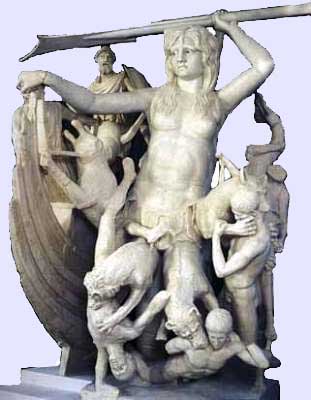
The Scylla Monster, a nymph transformed by Circe. Dogs as parts of her body eat six companions of Odysseus.
Laelaps the dog who never failed to catch what he was hunting once had to catch the Teumessian fox that could never be caught.
Greek Dogs: Races, ancient and modern
Some Preliminary information that I have collected
THE ANCIENT GREEK COMPANION DOGS ARE STILL AT HOME TODAY
Alopekis “believed to be the key progenitor of all terriers and many modern small dogs of Western Europe“ (Info)
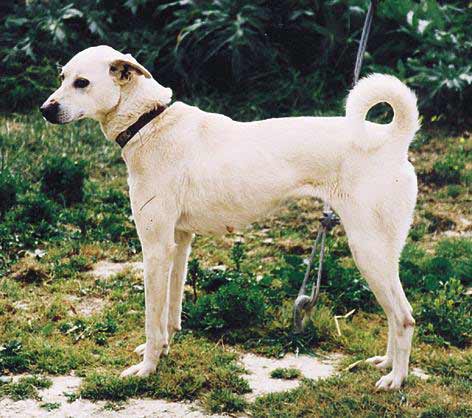
Cretan Hound (Image from STIGMES, the magazine of Crete, http://stigmes.gr)
The Cretan Hound (Κρητικός Λαγωνικός), Kritikos Ichnilatis
Hellenikos Poimenikos , See also Hellenic Sheepdog
Hellenikos Ichnilatis (Ελληνικός Ιχνηλάτης) , Ichnilatis Lakonias,
The Laconian hounds used by Xenophon were slow and hunted by smell alone and, if the trail was uncertain, the prey frequently escaped. That is why in Xenophon's account there is a description of other equipment, such as nets and snares. ....Xenophon must not have known of the Vertragus, says Arrian; otherwise, he never would have written that hounds cannot catch hares except by luck. Dogs in Ancient Greece and Rome
Hellenikos Katoikidios ??
Syrianos Diktis ??
Stories
Alcibiades had a dog which cost him seventy minas *, and was a very large one, and very handsome. His tail, which was his principal ornament, he caused to be cut off, and his acquaintances exclaiming at him for it, and telling him that all Athens was sorry for the dog, and cried out upon him for this action, he laughed, and said, "Just what I wanted has happened then. I wished the Athenians to talk about this, that they might not say something worse of me.", Plutarch Alcibiades (* seven thousand drachmae, the salary was 1 drachma or less for a worker)
Pythagoras: When he saw that a young dog was beaten he said: Stop beating the dog who has the soul of a friend that I recognized.
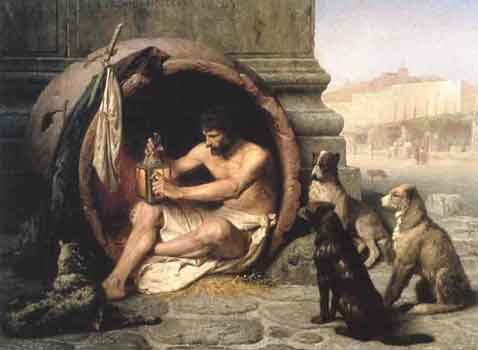
Diogenes, Jean-Léon Gérôme, 1860, Walters Art Museum, USA
The Philosopher Diogenes of Sinope (Διογένης ) (412 – 323 BC) called “The dog”
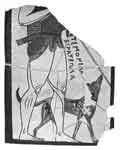

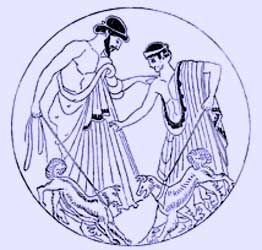

Didrachm, The river god Crimissus (in form of a dog), Head of Segesta
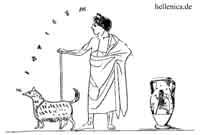
TODAY
As long as man continues to be the ruthless destroyer of lower livings beings, he will never know health or peace. For as long as men massacre animals, they will kill each other. Indeed, he who sows the seed of murder and pain cannot reap joy and love. Pythagoras , (Menschen, die Tiere töten, töten sich auch gegenseitig. Wer Tod und Schmerz sät, kann nicht die Früchte von Freude und Liebe ernten.) RELIGION, ANIMALS AND PEACE
Even if the story of Argos, the dog of Odysseus, shows that he was neglected I think dogs were considered in ancient Greece more important than in Greece today. Even the Gods had dogs, something that we cannot imagine in Christian Religion today.
Beware of the dogs, beware of the evil workers, beware of those who mutilate the flesh! Philippians 3:2, Outside are the dogs, those who practice magic arts, the sexually immoral, the murderers, the idolaters and everyone who loves and practices falsehood. Rev. 22:15
It is a problem of education and civilization. Nevertheless there are some individuals and organizations in Greece today who try to solve the problems with stray dogs (and other animals).
Some Lazy Greek Dogs (from Athens)
Images
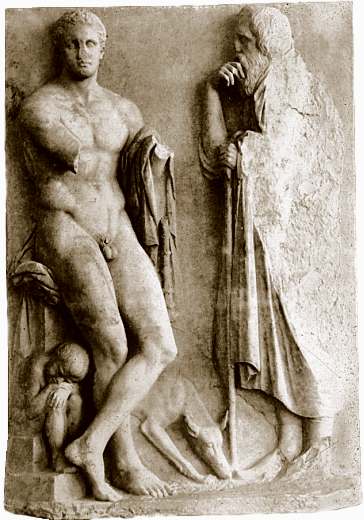
Ilissos Stele from the bed of the Ilissos River in Athens, c. 340 BC, National Museum, Athens. The young boy maybe represents one of the children of the dead. A grave stele which I find also funny because of the dog that smells the foot of the old man.
Dog Pictures on Vases (Perseus)
Some Comments of Aristotle about dogs, The History of Animals,
Dogs can be distinguished from one another, the young from the old, by their teeth; for the teeth in young dogs are white and sharp-pointed; in old dogs, black and blunt.
Of dogs there are several breeds. Of these the Laconian hound of either sex is fit for breeding purposes when eight months old: at about the same age some dogs lift the leg when voiding urine. The bitch conceives with one lining; this is clearly seen in the case where a dog contrives to line a bitch by stealth, as they impregnate after mounting only once. The Laconian bitch carries her young the sixth part of a year or sixty days: or more by one, two, or three, or less by one; the pups are blind for twelve days after birth. After pupping, the bitch gets in heat again in six months, but not before. Some bitches carry their young for the fifth part of the year or for seventy-two days; and their pups are blind for fourteen days. Other bitches carry their young for a quarter of a year or for three whole months; and the whelps of these are blind for seventeen days. The bitch appears go in heat for the same length of time. Menstruation continues for seven days, and a swelling of the genital organ occurs simultaneously; it is not during this period that the bitch is disposed to submit to the dog, but in the seven days that follow. The bitch as a rule goes in heat for fourteen days, but occasionally for sixteen. The birth-discharge occurs simultaneously with the delivery of the whelps, and the substance of it is thick and mucous. (The falling-off in bulk on the part of the mother is not so great as might have been inferred from the size of her frame.) The bitch is usually supplied with milk five days before parturition; some seven days previously, some four; and the milk is serviceable immediately after birth. The Laconian bitch is supplied with milk thirty days after lining. The milk at first is thickish, but gets thinner by degrees; with the bitch the milk is thicker than with the female of any other animal excepting the sow and the hare. When the bitch arrives at full growth an indication is given of her capacity for the male; that is to say, just as occurs in the female of the human species, a swelling takes place in the teats of the breasts, and the breasts take on gristle. This incident, however, it is difficult for any but an expert to detect, as the part that gives the indication is inconsiderable. The preceding statements relate to the female, and not one of them to the male. The male as a rule lifts his leg to void urine when six months old; some at a later period, when eight months old, some before they reach six months. In a general way one may put it that they do so when they are out of puppyhood. The bitch squats down when she voids urine; it is a rare exception that she lifts the leg to do so. The bitch bears twelve pups at the most, but usually five or six; occasionally a bitch will bear one only. The bitch of the Laconian breed generally bears eight. The two sexes have intercourse with each other at all periods of life. A very remarkable phenomenon is observed in the case of the Laconian hound: in other words, he is found to be more vigorous in commerce with the female after being hard-worked than when allowed to live idle.
The dog of the Laconian breed lives ten years, and the bitch twelve. The bitch of other breeds usually lives for fourteen or fifteen years, but some live to twenty; and for this reason certain critics consider that Homer did well in representing the dog of Odysseus as having died in his twentieth year. With the Laconian hound, owing to the hardships to which the male is put, he is less long-lived than the female; with other breeds the distinction as to longevity is not very apparent, though as a general rule the male is the longer-lived.
The dog sheds no teeth except the so-called ‘canines’; these a dog of either sex sheds when four months old. As they shed these only, many people are in doubt as to the fact, and some people, owing to their shedding but two and its being hard to hit upon the time when they do so, fancy that the animal sheds no teeth at all; others, after observing the shedding of two, come to the conclusion that the creature sheds the rest in due turn. Men discern the age of a dog by inspection of its teeth; with young dogs the teeth are white and sharp pointed, with old dogs black and blunted.
In all genera in which the distinction of male and female is found, Nature makes a similar differentiation in the mental characteristics of the two sexes. This differentiation is the most obvious in the case of human kind and in that of the larger animals and the viviparous quadrupeds. In the case of these latter the female softer in character, is the sooner tamed, admits more readily of caressing, is more apt in the way of learning; as, for instance, in the Laconian breed of dogs the female is cleverer than the male. Of the Molossian breed of dogs, such as are employed in the chase are pretty much the same as those elsewhere; but sheep-dogs of this breed are superior to the others in size, and in the courage with which they face the attacks of wild animals.
..Dogs that are born of a mixed breed between these two kinds are remarkable for courage and endurance of hard labour.
..Dogs when they are ill, eat some kind of grass and produce vomiting....Dogs, when they suffer from worms, eat the standing corn....The polecat or marten is about as large as the smaller breed of Maltese dogs.
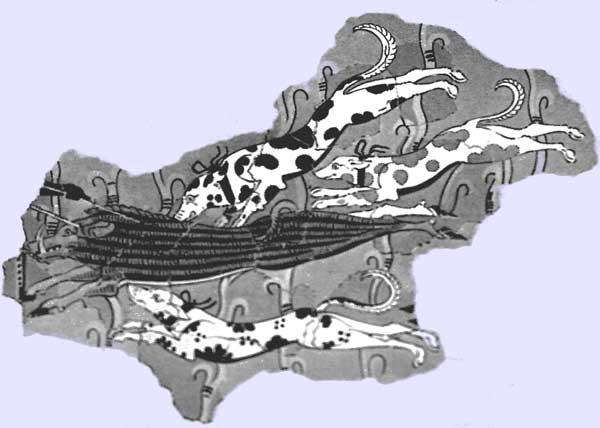
Tiryns, Boar Hunt with dogs, Fresco, c. 13th century BC
Ctesias' strange stories about India
The Indian dogs are very large and even attack lions,...On these mountains there live men with the head of a dog, whose clothing is the skin of wild beasts. They speak no language, but bark like dogs,... They understand the Indian language but are unable to converse, only barking or making signs with their hands and fingers by way of reply, like the deaf and dumb. They are called by the Indians Calystrii, in Greek Cynocephali ("dog-headed"). [They live on raw meat.] They number about 120,000. (It is is assumed that the book of Ctesias represents opinions of the Persians about India)
Looking for a dog name?
Male Dog Names With A Greek Or Latin Influence (The author has forgotten the most important name: Argos, the dog of Odysseus)
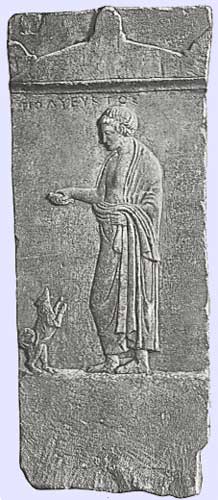

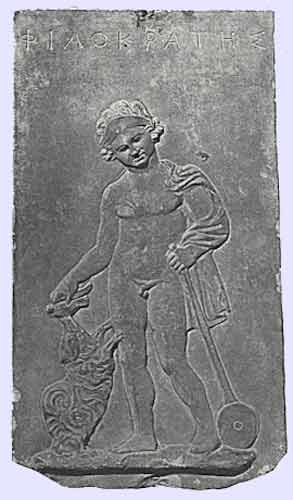
Attic Stele, left inscription "Polyeuktos", right "Philocrates", a young boy with a typical one-wheel toy
Reports in Greek
Έξοδος 22:31, Ιώβ 30:1, Α' Σαμουήλ 24:15)
Στην Αγία Γραφή υπάρχουν αρκετές αναφορές για σκύλους που περιέρχονται στους αγρούς και τους δρόμους για να τραφούν από πτώματα και απορρίμματα κρεάτων (Α' Βασιλέων 14:11, 16:4, 21:19), για το λόγο αυτό ήταν ζώα αντιπαθή (Ψαλμός 22:16,20, Ιερεμίας 15:3). Πολλές φορές όμως χρησίμευαν στη φύλαξη κοπαδιών προβάτων (Ιώβ 30:1). Μεταφορικά ο απ. Παύλος ονομάζει τους ψευτοδιδασκάλους "κύνες" (Φιλιππησίους 3:2), ενώ όσοι θα βρεθούν έξω από τη βασιλεία των ουρανών χαρακτηρίζονται "κύνες", λόγω τις αμαρτωλής τους ζωής (Αποκάλυψη 22:15). Source: http://www.jesuslovesyou.gr/Bible_club/Encyclopedia/Zoo/Animal_2.htm
Ο "ΕΛΛΗΝΟΧΡΙΣΤΙΑΝΙΚΟΣ ΜΑΣ ΠΟΛΙΤΙΣΜΟΣ“
Ancient Greek Dog names
According to Ovid the dogs of Actaeon were:
Aello, Agre, Agriodus, Alce, Astolus, Conace, Dorceus, Dromas, Harpalos, Harpyia, Hylactor, Hyläus, Ichnobates, Labros, Lachne, Lacon, Ladon, Laelaps, Leucon, Lysice, Malampus, Melanchaetes, Melaneus, Nape, Nebrophonus, Oresitrophus, Oribasus, Pamphagus, Poemenis, Pterelas, Stilbe, Theridamas, Theron, Thous, Tigris.
German Reports
Bernhard Schlag, Thematische Bindungen der Hundedarstellungen im bronzezeitlichen Griechenland ,Forum Archaeologiae - Zeitschrift für klassische Archäologie 8 / IX / 1998
Images
Hermes sacrificing a dog disguised as a pig ?
Hunting hares: the young hunter and the old hunter.
Links
Kenneth F. Kitchell, Jr, Man’s best friend? The changing role of the dog in Greek society (PDF)
Dogs in Ancient Greece and Rome
Athens Canine Society
Dog as Deity, Ancestor and Royal Animal
INTRODUCTION TO THEOLOGY AND ANIMALS , http://www.ape-connections.org/
Ein Kampagne für den Tierschutz in Griechenland
Over 10,000 Dog Supply Products. Order Today for Huge Savings!
Xenophon The Sportsman (The Cynegeticus) deals chiefly with the hare, though the author speaks also of boar-hunting and describes the hounds, tells how they are to be bred and trained, and gives specimens of suitable names for them
| Ancient Greece
Science, Technology , Medicine , Warfare, , Biographies , Life , Cities/Places/Maps , Arts , Literature , Philosophy ,Olympics, Mythology , History , Images Medieval Greece / Byzantine Empire Science, Technology, Arts, , Warfare , Literature, Biographies, Icons, History Modern Greece Cities, Islands, Regions, Fauna/Flora ,Biographies , History , Warfare, Science/Technology, Literature, Music , Arts , Film/Actors , Sport , Fashion --- |

